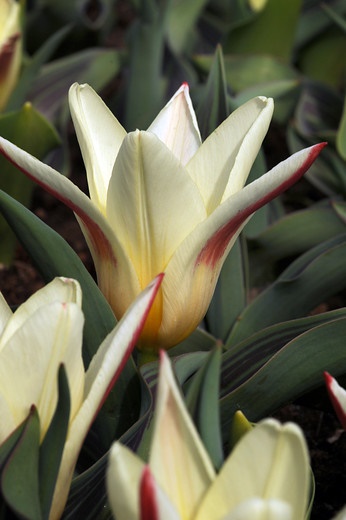Flowering period: early
Average plant height: 10 – 20 cm
Spacing between bulbs: 7.5 cm
Type of bulb: bulb
Landscape uses: beds, borders and rock gardens
These small tulips, native to the wilds of Turkistan, were named Tulipa kaufmanniana. They were first introduced to Europe in 1877 by the Dutch company Van Tubergen. The flowers have creamy-white petals on the inside, blending into pink-red on the outside, with a distinct yellow base. While the original species is still cultivated, it’s produced only in very limited quantities today.
What makes this species stand out are its short stems and its foliage, which is often speckled or striped.
Over the years, stunning cultivars have been developed from this species. Breeding has produced larger flowers, famous for their vivid, contrasting colors. On sunny days, the blooms open wide, revealing an entirely different color effect than when they’re closed. Their shape transforms as well—when fully open, they resemble a bright, shining star.
These early-blooming tulips are especially striking in rock gardens and containers, and they also naturalize with ease.
Most significant cultivars
- ‘Fashion’: scarlet red flowers
- ‘Giuseppe Verdi’: carmine red, yellow-edged flowers *
- ‘Cluck’: carmine red, bright yellow-edged flowers *
- ‘Heart’s Delight’: carmine red, pale pink-edged flowers *
- ‘Johann Strauss’: currant red, pale yellow-edged flowers *
- ‘Scarlet Baby’: scarlet red flowers
- ‘Showwinner’: cardinal red flowers *
- ‘Stresa’: currant red and yellow flowers *
* this cultivar has spotted foliage.
As is the case with most other tulip classes, these are also offered as mixed colors.

